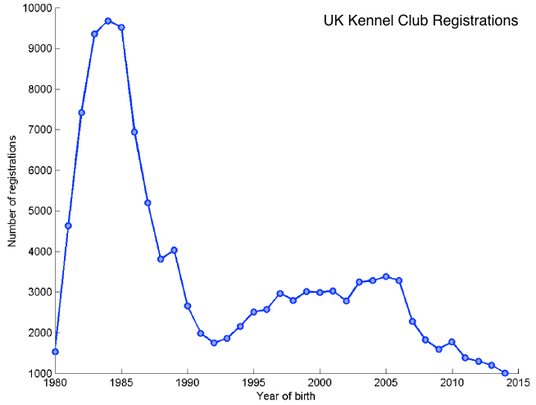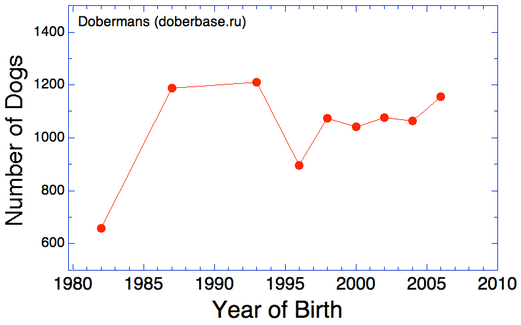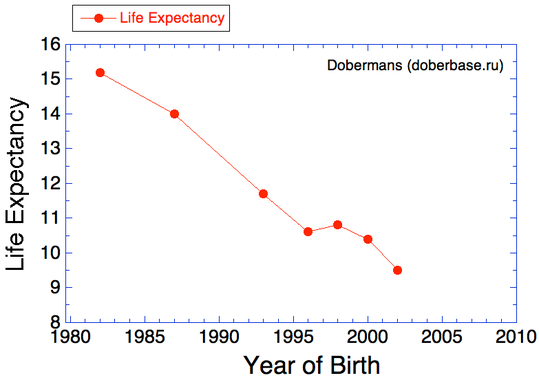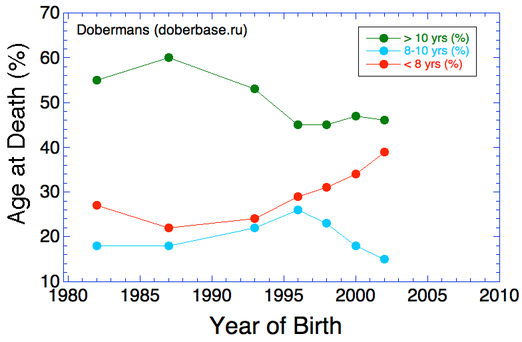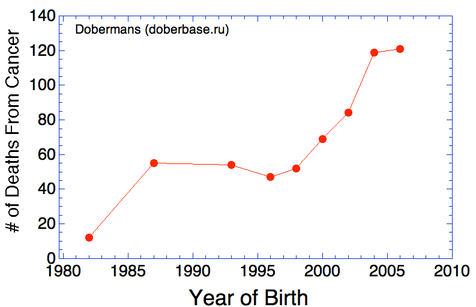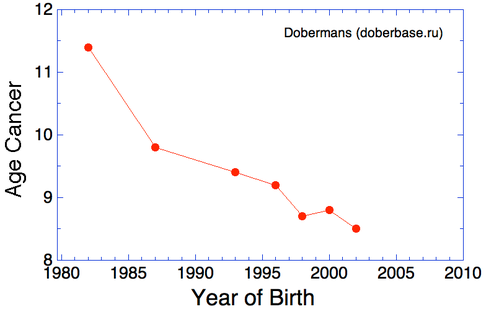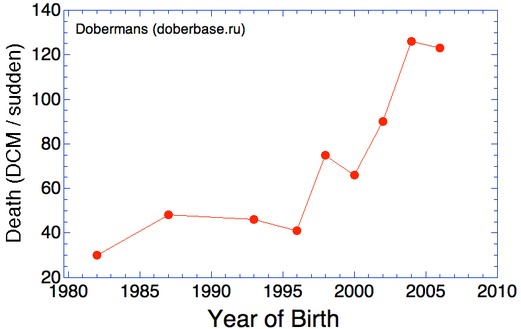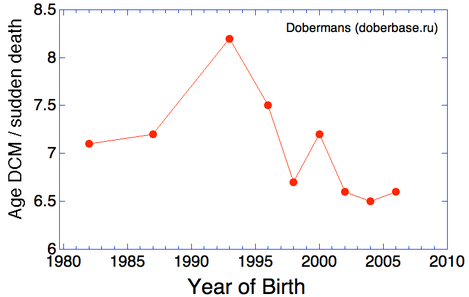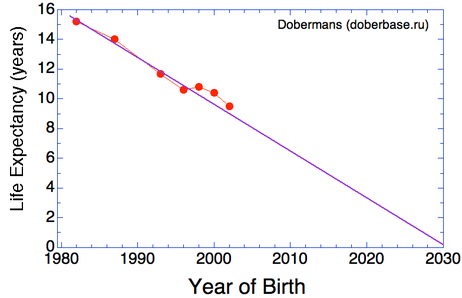I have compiled a substantial amount of data about the genetic status of the breed (see references below), and there should be no question that the Doberman is in desperate need of rescue. But I am unaware of any effort (at least in the US) that is focused on increasing the size of the gene pool of the breed, which would require a cross-breeding program unless there are some populations hidden away that are dramatically different genetically. Further, there is no program dealing with the issue of population genetic management to minimize the loss of genetic diversity at the level of the entire breed.
If the information already available wasn't sufficient to convince breeders of the urgency of undertaking a genetic rescue, I am not optimistic that even more data will push anybody towards taking action. However, I stumbled on some very interesting data that are worth looking at, and for the sake of completeness I am posting them here. Note that these are not my data; they are (apparently) data for dogs in Russia (http://doberbase.ru), with information supplied by owners, so they can't be assumed to be either complete or unbiased. All I have access to are tables and charts on the website that present single numbers (e.g., a mean or maximum), not the values for individual animals. The data are for dogs born between 1982 and 2007. Because you can't have mortality data on dogs that haven't died yet, the statistics don't run to the current date.
Since the mid-1980s, the number of dogs born per year has hovered between 1000 and 1200 per year.
For dogs born in the early 1980s, the average life expectancy was 14 years or better, but it has been declining steadily since. Dogs born in the early 2000s have an expected average lifespan of about 10 years - 50% less than 30 years ago.
The decline in lifespan is also reflected in the graph below, which shows that the percentage of dogs that live more than 10 years has been declining over the last 3 decades, and the fraction that don't survive past 8 years is increasing.
The website does not present data for all causes of death, but there are statistics for both cancer and DCM. These graphs tell a stark story. Since the 1980s, more and more dogs have been dying of cancer and DCM (top graphs), and they die at younger and younger ages (bottom graphs). Note that these increases in mortality cover a period when the number of dogs born per year has remained relatively constant (see the first graph above).
If you have a ruler and pencil, you can print off a few of these graphs and extrapolate to the hypothetical date of extinction. When I do that for the life expectancy data, extinction is predicted in about 2030, only 13 years from now. In fact, dogs born today would have an expected lifespan of less than 5 years if this extrapolation is correct. Of course, there is no way to know if this line continues on the same trajectory for the next few decades, but there is no compelling reason to think that it won't; there have been no breakthroughs in eliminating DCM, and research on cancer is unlikely to reduce the number of animals afflicted. In fact, extrapolation of the line for the incidence of DCM from another body of data indicates that 100% of the breed will be afflicted by 2040. If cancer doesn't drive them to extinction, DCM will.
These data simply add to the substantial body of very convincing evidence that this breed is rushing headlong towards extinction.
A lay person viewing this situation from outside the fancy would no doubt expect to see custodians of the Doberman focused like a laser on the goal of turning this ship around. At the very least, there should be alarm, a sense that this is a desperate time for this breed. But there is no alarm, no anxiety about impending doom. In fact, very little is happening that will make a difference to this breed.
A new non-profit called the Doberman Diversity Project aims to genotype 1,000 Dobermans "to help Breeders improve the health and longevity of the breed by creating affordable access to cutting-edge, high-resolution DNA testing and online breeding tools...for one important goal: improved longevity & genetic health in the Doberman worldwide." While I applaud the efforts of this group, I don't see how this will improve the situation of the breed. With a small gene pool and 40% inbreeding (so everybody has the same genes and they are highly homozygous), there simply isn't much to work with - selection requires genetic variation, and there isn't any. We can do little more than push the same peas around on the plate. There isn't much time either - the life expectancy for dogs born 5 years from now in 2022 is only about 3 years. The window of time for doing something to save this breed is very narrow.
Oddly, in his article about dog breeding, Sayers defined the term "preservation breeder" in the context of a cultural rather than genetic resource, as it would apply for example to things like historic buildings under the management of the National Park Service (NPS). By this definition, he says, "anyone who breeds purebred dogs is a preservationist".
"Preservation breeder" as used now by the dog fancy has little to do with preserving a breed, at least as commonly defined and as as used by Sayers. Preservation breeding requires sustainable breeding - the point being to produce a next generation of animals that is as healthy and fit as their parents. This requires more than simply producing a litter of puppies from purebred parents. That we are not maintaining health from one generation to the next is obvious from the trajectories of the graphs above for lifespan and for DCM and cancer. This is most certainly not preservation breeding.
As Sayers notes, "when disease threatens a breed's future and the health and welfare of individual animals is at stake, it may become imperative to consider doing the unthinkable" (italics mine).
The breeders at the core of the fancy are adverse even to the notion that the breed is on genetic last legs. If "the unthinkable" is unthinkable, then what plan do breeders have to save this breed? Is this at the top of the agenda of the national breed club? Is the health committee worried about specific genetic issues instead of extinction? Who will step up to the plate and save this breed before it is too late?
| "Today's preservation breeders have come to realize that our beloved breeds - and the clubs and events that support them - can no longer exist within the status quo. As cultural, economic and technological changes continue to forge a scism between serious dog breeders and everyone else who cares deeply for dogs, the time is nigh to implement a determined course of action that guarantees our breeds will be preserved in perpetuity. So, what kind of preservation breeder are you?" (emphasis mine; Sayers 2017) |
Beuchat C. 2016. Are we watching the extinction of a breed? (part 2)
Beuchat C. 2017 An update on the genetic status of the Doberman Pinscher
ICB's online courses
***************************************
Visit our Facebook Groups
ICB Institute of Canine Biology
...the latest canine news and research
ICB Breeding for the Future
...the science of animal breeding
